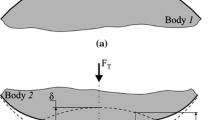Abstract
In this paper we examine briefly the reliability of solution needed for the accurate and effective analysis of engineering design problems involving contact conditions. A general finite element formulation for treating the frictional contact problem using constraint functions is first summarized. Then we address general reliability issues and those related to the selection of appropriate elements that provide optimal performance. These elements of course do not lock and would provide the best solution an analyst can expect when simulating a design problem. Reliability issues specific to the contact formulation are also presented. A promising procedure to increase the reliability of an analysis is the method of finite spheres. The method does not require a mesh and in particular can be used with a finite element discretization as described in the paper. Finally, the results of several illustrative analysis problems are given.
Similar content being viewed by others
References
ADINA R&D, Inc. (2002). ADINA Theory and Modeling Guide. Volumes I, II, III, Watertown, MA.
Bathe, K.J. (1996). Finite Element Procedures. Prentice Hall, New Jersey.
Bathe, K.J. (2001a). The inf-sup condition and its evaluation for mixed finite element methods. Computers and Structures79, 243–252, 971.
Bathe, K.J. (ed.) (2001b). Computational Fluid and Solid Mechanics. Proceedings of the First MIT Conference on Computational Fluid and Solid Mechanics. Elsevier Science.
Bathe, K.J. (ed.) (2003). Computational Fluid and Solid Mechanics 2003. Proceedings of the Second MIT Conference on Computational Fluid and Solid Mechanics. Elsevier Science.
Bathe, K.J. and Brezzi, F. (2001). Stability of finite element mixed interpolations for contact problems. Proceedings of the National Academy of Lincei 12, 159–166.
Bathe, K.J., Lee, P.S. and Hiller, J.F. (2003). Towards improving the MITC9 shell element. Computers and Structures 81, 477–489.
Brezzi, F. and Fortin, M. (1991). Mixed and Hybrid Finite Element Methods, Springer.
Chapelle, D. and Bathe, K.J. (2003). The Finite Element Analysis of Shells-Fundamentals, Springer.
Crisfield, M.A. (2000). Re-visiting the contact patch test. International Journal for Numerical Methods in Engineering 48, 435–449.
De, S. and Bathe, K.J. (2000). The method of finite spheres. Computational Mechanics 25, 329–345.
De, S. and Bathe, K.J. (2001a). Displacement/pressure mixed interpolation in the method of finite spheres. International Journal for Numerical Methods in Engineering 51, 275–292.
De, S. and Bathe, K.J. (2001b). The method of finite spheres with improved numerical integration. Computers and Structures 79, 2183–2196.
De, S., Hong, J.W. and Bathe, K.J. (2003). On the method of finite spheres in applications: towards the use with ADINA and in a surgical simulator. Computational Mechanics 31(1-2), 27–37.
El-Abbasi, N. and Bathe, K.J. (2001). Stability and patch test performance of contact discretizations and a new solution algorithm. Computers and Structures 79, 1473–1486.
Eterovic, A.L. and Bathe, K.J. (1991). On the treatment of inequality constraints arising from contact conditions in finite element analysis. Computers and Structures 40, 203–209.
Hiller, J.F. and Bathe, K.J. (2003). Measuring convergence of mixed finite element discretizations: An application to shell structures. Computers and Structures 81, 639–654.
Hong, J.W. and Bathe, K.J. (2003). On analytical transformations for efficiency improvements in the method of finite spheres. In K.J. Bathe (ed.) Computational Fluid and Solid Mechanics. Elsevier.
Hong, J.W. and Bathe, K.J. (2004). Coupling and enrichment schemes for finite element and finite sphere discretizations. Computers and Structures, to appear.
Irons, B.M. and Razzaque A. (1972). Experience with the patch test for convergence in finite elements. In A.K. Aziz (ed.) The Mathematical Foundations of the Finite Element Method with Applications to Partial Differential Equations. Academic Press, New York, pp. 557–587.
Pantuso, D., Bathe, K.J. and Bouzinov, P.A. (2000). A finite element procedure for the analysis of thermomechanical solids in contact. Computers and Structures 75, 551–573.
Wriggers, P. (2002). Computational Contact Mechanics. Wiley, Hoboken, NY, 441 pp. 16 N. Elabbasi et al.
Author information
Authors and Affiliations
Rights and permissions
About this article
Cite this article
Elabbasi, N., Hong, JW. & Bathe, KJ. On the Reliable Solution of Contact Problems in Engineering Design. Mechanics and Materials in Design 1, 3–16 (2004). https://doi.org/10.1023/B:MAMD.0000035458.72478.7a
Issue Date:
DOI: https://doi.org/10.1023/B:MAMD.0000035458.72478.7a




